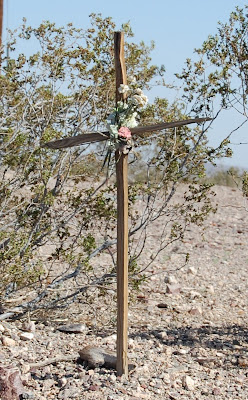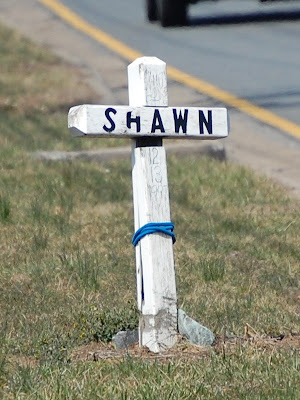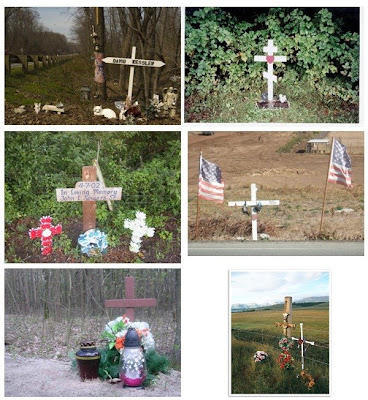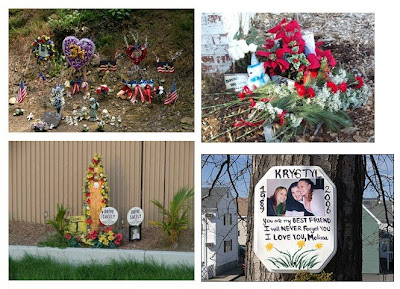The day after my return from California, I reported on the most memorable sight of the trip, the Watts Towers. Just a few days earlier, in the Mojave Desert, I had seen a piece of folk art that is quite a bit more modest.
 We've all seen little crosses—and more elaborate displays—beside the road, commemorating a spot where someone died in a collision. This one is right at the Lavic overpass, where old Route 66 (now National Trails Highway in that area) crosses over US 40. That is a perfect spot for an accident, because the left turn is as sharp as road-building technology can make it. Of course, the roadbed is rough enough that it is hard to travel at a dangerous speed.
We've all seen little crosses—and more elaborate displays—beside the road, commemorating a spot where someone died in a collision. This one is right at the Lavic overpass, where old Route 66 (now National Trails Highway in that area) crosses over US 40. That is a perfect spot for an accident, because the left turn is as sharp as road-building technology can make it. Of course, the roadbed is rough enough that it is hard to travel at a dangerous speed.This little cross, about three feet high, is apparently of found material, but it is the decoration that interests me. There is no name that I can see; it is a memorial understood only by the maker. But he or she was prompted to add a spray of plastic flowers. Perhaps the unadorned cross was just too stark.
These expressions of love and grief interest me as abundant examples of folk art. Though most are erected very quickly, they are often very beautiful. They seem to hark back to the beginnings of funerary art, before we all began to pay professionals to produce granite or marble memorials for grave sites. With this little cross in Lavic, I decided to photograph any that I see, particularly now that many states have begun to remove them. Here I will show just a couple of others, from my local area.
 At the intersection of US 202 and Silverside Road in Talleyville, Delaware, this is about as simple as they come. It is hard to get in a position for a good photograph. Both roads are very busy, and this is on a median right below the traffic signal.
At the intersection of US 202 and Silverside Road in Talleyville, Delaware, this is about as simple as they come. It is hard to get in a position for a good photograph. Both roads are very busy, and this is on a median right below the traffic signal.I've seen it there for more than ten years. It is barely possible to make out the date, 12/13/1997.
I used a long lens from a nearby parking lot. It wasn't easy even to get to a parking lot on the median, across a feeder. This is one aspect of these memorials: Putting them up, or getting to the place you want to put them, is often risky. I can think of two I'd like to photograph, but it will require stopping on the wrong side of a feeder or freeway ramp to do so.
 Crosses are the most common motif of roadside memorials. Enter "roadside memorial" in a Google Images search box, and you'll see what I mean. This montage is taken from the first two pages of returns. The second item is a Russian Orthodox cross. I suspect there are also Celtic crosses out there.
Crosses are the most common motif of roadside memorials. Enter "roadside memorial" in a Google Images search box, and you'll see what I mean. This montage is taken from the first two pages of returns. The second item is a Russian Orthodox cross. I suspect there are also Celtic crosses out there.Of course, only Christians and the nonreligious who are sympathetic to Christian imagery use crosses. I have yet to see a Jewish or Hindu motif, but I'll snap one if I see it.
 Christian or not, many memorials do not use crosses, though nearly all use flowers. This one appeared near the driveway into Brandywine High School three years ago.
Christian or not, many memorials do not use crosses, though nearly all use flowers. This one appeared near the driveway into Brandywine High School three years ago. Some memorials use hearts, some use pictures, and one in this montage uses a surfboard. The elements are meaningful to the maker, and usually to the victim. What is most distinctive, however, is that unlike most folk art, they are intended for display, and are placed at a meaningful location rather than in one's home (though I expect that many memorializers have a shrine to the victim in the home also, for at least some period of time).
Some memorials use hearts, some use pictures, and one in this montage uses a surfboard. The elements are meaningful to the maker, and usually to the victim. What is most distinctive, however, is that unlike most folk art, they are intended for display, and are placed at a meaningful location rather than in one's home (though I expect that many memorializers have a shrine to the victim in the home also, for at least some period of time).I had thought to make a significant effort to collect images of these ephemeral pieces of folk art. They'd make a good subject for a book. As it turns out...
 Holly Everett has written such a book, which is published by Texas A&M U. I should have known. It is too good a subject to remain unpublished this late. Though in her title Ms Everett mentions only Crosses, she discusses memorials of all kinds. You may consider this a pre-review of the book. I suspect it'll show up where I can get it before long.
Holly Everett has written such a book, which is published by Texas A&M U. I should have known. It is too good a subject to remain unpublished this late. Though in her title Ms Everett mentions only Crosses, she discusses memorials of all kinds. You may consider this a pre-review of the book. I suspect it'll show up where I can get it before long.Meantime, I'll continue to photograph these roadside memorials wherever I find them. Note that only the three larger images in this post are mine. The two montages were pasted together from images found on the web, and the book cover is from the TAMU web site linked above.



No comments:
Post a Comment